Neuengamme Concentration Camp
Photos of Memorial Site by Bonnie
M. Harris
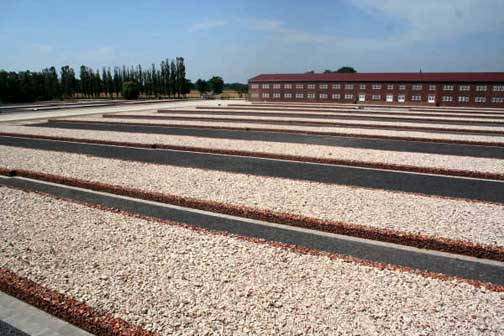 Gravel beds show the
outline of the former barracks buildings
Photo Credit: Bonnie
M. Harris
Gravel beds show the
outline of the former barracks buildings
Photo Credit: Bonnie
M. Harris
Neuengamme remained a sub-camp of Sachsenhausen
until June 1940, when it became an independent concentration
camp of 18 barracks built in 9 rows. These rows of barracks are
demarcated today by slightly raised gravel beds showing the place
where the barracks once stood.
At first, prisoners slept on the floor
but after 1941, they were provided with three-tier bunk beds.
The Barracks, called "blocks," were designed to hold
about 200 people, but according to the Memorial site, "the
blocks were mercilessly overfilled, sometimes with 400 prisoners
per block. The sanitary facilities were utterly inadequate and
the level of hygiene below all human dignity."
These same barracks were used by the
British to imprison suspected German war criminals from 1945
to 1948. The barracks were demolished in 1949 and replaced with
a new tract of prison cells, after the camp was handed over by
the British to Hamburg's justice department.
Neuengamme's prisoner population in 1940
was over 1,100. By July 1941, the number of prisoners increased
to over 5,000. Due to chronic overcrowding and unsanitary conditions,
typhus became an ongoing problem. Over 1,000 prisoners died during
an outbreak of typhus that began in December 1941.
As the war progressed and the shortage
of labor increased, the SS expanded the use of slave labor from
concentration camps in the armament factories. By mid-January
1945, the Neuengamme Camp system consisted of about 60 satellite
camps with an inmate population of approximately 50,000 prisoners.
From April 1942, when the SS completed
construction of a crematorium at Neuengamme, the bodies of prisoners
who died in the camp were cremated and the ashes spread in the
camp gardens. The prisoner death rate continued to rise, and
the SS later constructed a second crematorium.
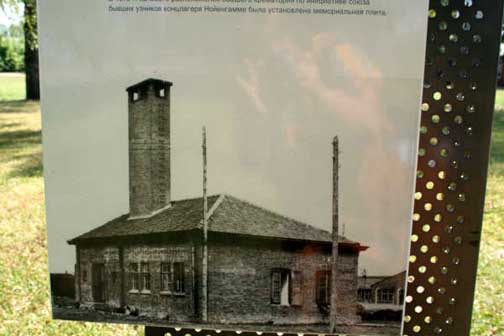 Display shows photo
of the crematorium building
Photo Credit: Bonnie
M. Harris
Display shows photo
of the crematorium building
Photo Credit: Bonnie
M. Harris
This picture, which is displayed at Neuengamme
today, shows how the crematorium once looked. The crematoria
were demolished in late 1946 and early 1947. A memorial plaque
was placed in the location of the first crematorium in 1970.
It is shown in the photo below.
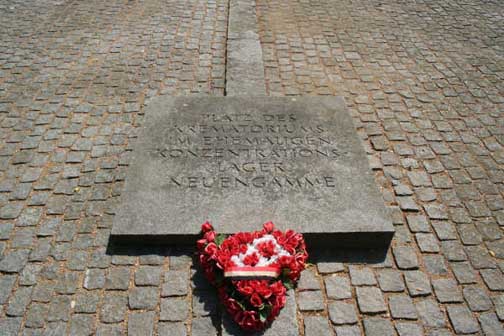 Memorial marks the
spot where bodies were burned in the crematorium
Photo Credit: Bonnie
M. Harris
Memorial marks the
spot where bodies were burned in the crematorium
Photo Credit: Bonnie
M. Harris
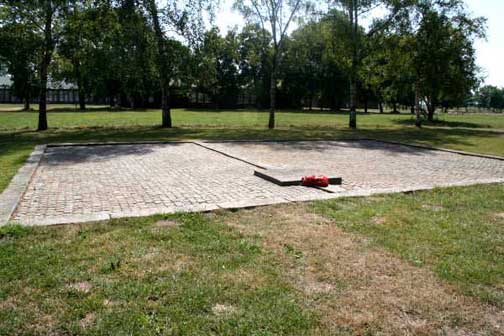 The outline of the
former crematorium building
Photo Credit: Bonnie
Harris
The outline of the
former crematorium building
Photo Credit: Bonnie
Harris
Of the 106,000 inmates held at Neuengamme
and its sub-camps, approximately 55,000 died from starvation,
disease, abuse, experimentations, and executions, according to
information given at the Memorial Site. According to the United
States Holocaust Museum, precise numbers for Neuengamme are unknown
because the camp records were burned by the SS before the British
liberators arrived. Although Neuengamme was a labor camp, not
a death camp, and did not have a gas chamber, the 52% death rate
during its 8 years of existence was far higher than the 15% death
rate at the Dachau main camp where 31,951 out of 206,206 prisoners
died during a 12 year period and half of these deaths were in
the last six months of the war when a typhus epidemic devastated
the Dachau camp.
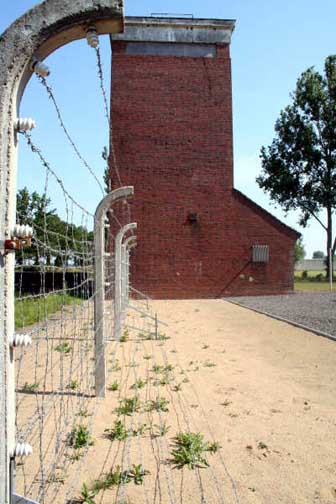 Barbed wire fence and
guard tower at Neuengamme camp
Photo Credit: Bonnie
M. Harris
Barbed wire fence and
guard tower at Neuengamme camp
Photo Credit: Bonnie
M. Harris
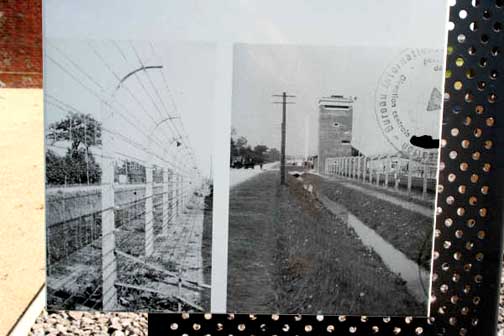 Display shows photos
of original fence
Photo Credit: Bonnie
M. Harris
Display shows photos
of original fence
Photo Credit: Bonnie
M. Harris
The camp's fence consisted of several
parts. In addition to the electrically charged barbed wire that
was held in place by the bent concrete pillars, there was also
a diagonal wire fence which was constructed with the intention
of preventing prisoners from committing suicide by throwing themselves
onto the charged barbed wire.
There were paths on both sides of the
fence, along which the SS guards patrolled. On the inside, the
path was bordered by an area of raked sand in which footprints
could be instantly seen.
The watchtowers were manned with sentries
equipped with machine guns and searchlights, with which the fence
could be additionally illuminated. This part of the fence was
reconstructed to illustrate these security measures. The original
sawed-off fastenings for the barbed wire and two porcelain rings
that held the electric wires can still be seen in the wall of
the watchtower.
|